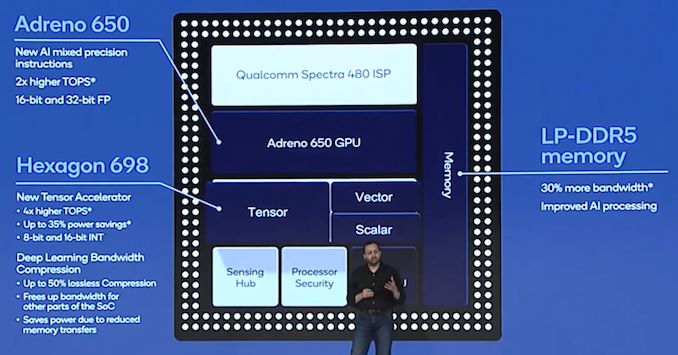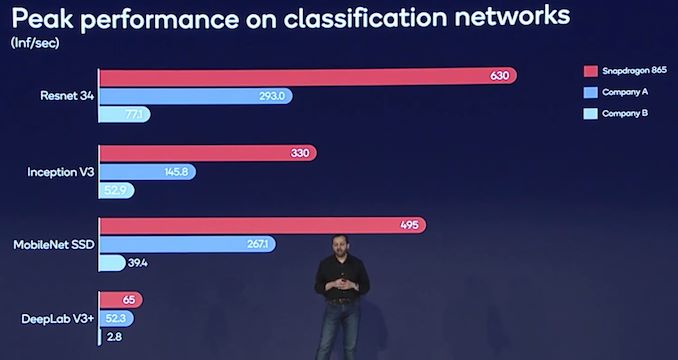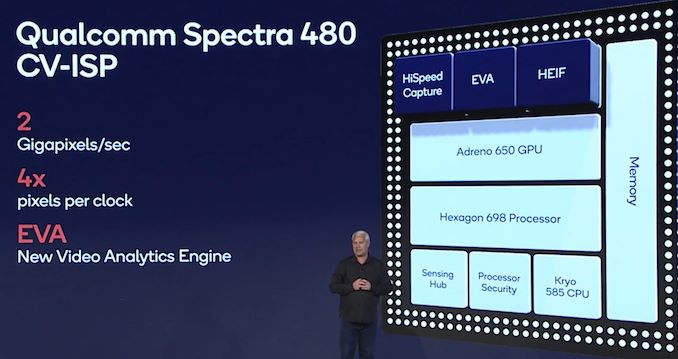Qualcomm Announces Snapdragon 865 and 765(G): 5G For All in 2020, All The Details
by Andrei Frumusanu on December 4, 2019 1:50 PM EST- Posted in
- Mobile
- Qualcomm
- Smartphones
- SoCs
- 7nm
- 5G
- Snapdragon 865
- Snapdragon 765
Immense AI, Camera and ISP Upgrades
New Hexagon 695 DSP: 4x Performance On New Tensor Cores - 15 TOPs Total on SoC
The Snapdragon 865 now ships with the new Hexagon 695 DSP block. The single biggest improvement of the new design is a massive quadrupling of the processing power of the dedicated tensor cores. This jump alone is able to double the SoC’s aggregate AI processing ability up from 7 TOPs to 15 TOPs.
Qualcomm here still doesn’t properly do a breakdown between the IP blocks which contribute to this number, but given that the GPU only saw a ~20% increase, and that the Hexagon’s scalar and vector execution units this year have remained the same in terms of performance, we estimate that the tensor units now roughly come in at around 10TOPs by themselves.
Qualcomm has also now included lossless weight and activation compression for the Tensor cores, being able to reduce bandwidth consumption up to 50%. This is a similar feature we've seen advertised by third-party NPU IP offerings, only that Qualcomm is going to be shipping this now in a product in just a few months.
Power efficiency of the block is also have said to have improved by 35%, making computations less costly in terms of battery life.
Qualcomm talks how about its inference performance and inference power efficiency is significantly higher than competing solutions. We don't know the comparison SoCs being showcased here, but a likely candidates here are the Apple A13 and the Kirin 990? It could also be an Exynos or other SoC.
New Spectra CV-480 ISP: 2 Gigapixels/s Enabling Massive Sensors
Aside from its 5G abilities, it’s very much evident that camera is very much at the very centre of the Snapdragon 865’s new features. The whole camera subsystem has seen some massive upgrades in the IP, and amongst the biggest improvements in capability lies in the new Spectra 480 computer-vision ISP.
The new IP has seen a major architectural change in that it’s now able to process 4 pixels per clock instead of just only 1 PPC as in the previous generation. This has now massively upgraded the pixel processing throughput to 2 Gigapixels/second, allowing the SoC a wide variety of use-cases that in the past simply weren’t possible due to lack of raw power.
Starting off with video capture, the new SoC is able to now record in 4K HDR while simultaneously capturing up to 64MP still shots at the same time. But 4K video isn’t the limit anymore – and you even can say that in terms of framerate as now 4K120 recording is supported, but the Snapdragon 865 now supports 8K30 video recording.
Video recording quality continues to support all the features we’ve seen in the previous generation, meaning 10-bit and various HDR standards such as HLG, HDR10, HDR10+, but now the new SoC expands this even further with the introduction of the ability to do live recording in the Dolby Vision HDR standard. Qualcomm explains that the Snapdragon 865 not only is the first smartphone SoC to be able to do this, but it’s the first camera platform of any kind in the world, as usual Dolby Vision content right now is enabled post-capture in the editing room, rather being something that’s being natively recorded by a camera.
The new improved capabilities of the ISP and video encoder also erase some current recording limitations, for example, slow-motion video recording at 960fps is sustained indefinitely instead of being limited to a couple of seconds of real-time footage.
Although normally I wouldn’t have brought this up, MediaTek’s recent release of the Dimensity 1000 did recently popularise the discussion topic: No, the Snapdragon 865 doesn’t support the AV1 codec for video decoding. It looks like we’ll have to wait for the next generation for that.
In terms of still capture photography, the new ISP performance will now allow for support for sensors of up to 200MP, which actually don’t yet exist as Samsung’s recent 108MP behemoth is currently the largest of its class right now.
The new ISP now has various new functionalities in order to improve noise reduction and contrast enhancements. Particularly the new noise reduction features is said to be quite difficult to achieve.
Although Qualcomm advertises the 200MP figure predominantly, it’s to be noted that actual capture with zero shutter lag (ZSL) is limited to 64MP – so there is a rather larger compromise in capturing at resolutions beyond 64MP.
High Refresh Rate Displays Normalised: Support For 144Hz
Already some vendors are leading the pack in 2019, but we’re expecting 2020 to see wide-range adoption of high refresh-rate displays. Even more importantly, we’ll be seeing implementations at high resolutions higher than 90 and 120Hz, supporting up to 144Hz displays. Qualcomm explains that the barrier that’s been lifted here is the SoC’s Display Processing Unit (DPU) that has had its throughput significantly increased.
I asked the company about the impact on battery life and which component of a phone accounts for the highest power increases. Surprisingly, it’s not any one component, with most of them seeing pretty much just an evenly distributed linear increase in power requirements, with the actual display panel itself (excluding the DDIC), seeing actually the least increases in power draw.















91 Comments
View All Comments
nandnandnand - Wednesday, December 4, 2019 - link
"No, the Snapdragon 865 doesn’t support the AV1 codec for video decoding."Insert the Crapdragon 865 into a region of spacetime exhibiting gravitational acceleration so strong that nothing can escape from it.
ksec - Wednesday, December 4, 2019 - link
Best Announcement to Date ever. Just to reiterate again Qualcomm is not a member of Open Media Alliance.And I hope AV1 wont gain any traction.
nandnandnand - Wednesday, December 4, 2019 - link
Prepare to be disappointed, loser.levizx - Thursday, December 5, 2019 - link
What an idiot.tijag - Wednesday, December 4, 2019 - link
So, reading through this, will Snapdragon 865 catch up to the A12 SoC then? Maybe in some benchmarks? How is Apple so far ahead? Is this just because Qualcomm basically has no competition?Wilco1 - Wednesday, December 4, 2019 - link
On floating point, quite possibly, but on integer it will be closer to A11 unless the L3 doubling and reduce memory latency help more than expected.It's about cost reduction. It would be possible to use a 1MB L2 on all cores, use a 16MB or even 32MB L3 and increase frequency to get an easy 15-20% gain. But who wants to pay $50 extra for a performance gain that is hard to notice?
tijag - Wednesday, December 4, 2019 - link
Using my wifes 11 Pro Max and the speed of everything is noticeable. switching apps, loading web pages, opening apps, touch inputs. everything feels better/faster.So whatever they are doing, i wouldn't say it isn't 'hard to notice'. At this point it is a near certainty i will upgrade my S10+ to next years iPhone. first time I'll have bought iOS phone. the gap is widening and it's finally at a point where i'll put up with things about iOS i don't prefer for the overall superior experience.
Raqia - Wednesday, December 4, 2019 - link
That said, the snappiness of iPhones doesn't have especially much to do with peak single threaded integer throughput so much as IO and memory performance coupled with tight integration of iOS with hardware. The everyday use performance gains are also much more due to the better smaller cores in the A13 and the gains this year are much more impressive than those for the large cores which fuel the headlining single threaded geekbench score driving the most peoples' performance perceptions.I myself have a OnePlus 5T with an 835 that feels very snappy on all the fronts you mention on the latest Oxygen OS build; it wasn't so with prior, less optimized Android images.
tijag - Wednesday, December 4, 2019 - link
I was comparing it to the Pixel 4 XL that we got and returned after she basically hated it. the iPhone 11 is her first iPhone for personal use [has one for work phone]. The pixel 4 sure didn't feel snappy or performant in the way the new iPhone does. If its only down to software/OS optimizations that doesn't really make me feel better about getting another android phone.I'm OG too, I had the T-Mobile G1 and loved it from the start.
I guess i'm too old now and basically just am willing to sacrifice certain preferences for overall improved UX.
Alistair - Wednesday, December 4, 2019 - link
I'm very disappointed with my Android phone's hardware, but I love the software. Poor battery standby time, poor CPU performance. At least I don't have to deal with AppleID nonsense (I've had 2 accounts lost from hacking from China in the last 10 years, and they can't just reset your accounts (this was before 2 factor) even I have control over the email addresses, so Apple lost me there. "Hello, I have the email address, send me a reset email" "Sorry we can't do anything, create another account" ... NONSENSE!!! I'm not making a third gmail account to make another AppleID account...